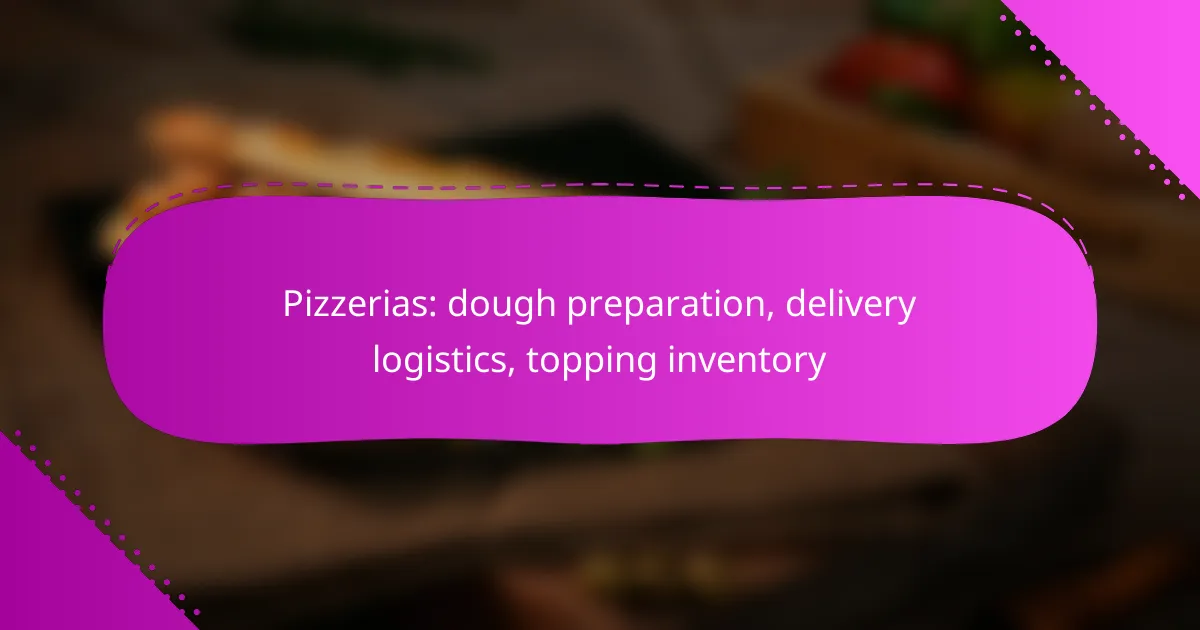Pizzerias play a vital role in the culinary landscape, with a focus on perfecting dough preparation to enhance flavor and texture through careful fermentation and resting techniques. Efficient delivery logistics are essential for maintaining food quality and customer satisfaction, achieved by optimizing routes and utilizing technology. Additionally, effective topping inventory management ensures that pizzerias can meet customer demands while minimizing waste through careful tracking and supplier relationships.

How do pizzerias prepare dough in Canada?
Pizzerias in Canada typically prepare dough using a combination of high-quality ingredients and specific techniques to achieve the desired texture and flavor. The process includes fermentation, mixing, and resting, which are crucial for developing the dough’s characteristics.
Cold fermentation techniques
Cold fermentation is a popular method among Canadian pizzerias, allowing the dough to rise slowly in a cooler environment, usually between 4°C to 10°C. This technique enhances the flavor and texture, resulting in a crust that is both chewy and flavorful.
To implement cold fermentation, pizzerias often prepare the dough in advance, allowing it to rest for 24 to 72 hours. This extended fermentation period helps develop complex flavors and improves the dough’s extensibility.
Common flour types used
In Canada, pizzerias commonly use high-protein flours, such as bread flour or Tipo “00” flour, which are ideal for pizza dough. Bread flour typically contains around 12-14% protein, providing the necessary gluten structure for a chewy crust.
Tipo “00” flour, originating from Italy, is finely milled and has a protein content of about 11-12%, making it suitable for Neapolitan-style pizzas. Choosing the right flour type is essential for achieving the desired crust characteristics.
Mixing and kneading methods
Mixing and kneading are critical steps in dough preparation. Pizzerias often use a stand mixer with a dough hook or hand kneading to combine ingredients thoroughly. Mixing should be done until the dough is smooth and elastic, typically taking about 8-10 minutes with a mixer.
During kneading, it’s important to avoid overworking the dough, as this can lead to a tough texture. A good rule of thumb is to knead until the dough passes the “windowpane test,” where a small piece can stretch thin without tearing.
Resting and proofing processes
Resting and proofing are essential for allowing the dough to relax and rise properly. After mixing, the dough should rest for at least 30 minutes before shaping, which helps reduce gluten tension.
Proofing typically occurs after shaping the dough into balls, allowing it to rise at room temperature for 1-2 hours. This step is crucial for developing the final texture and ensuring the dough is airy and light when baked.

What are the best delivery logistics for pizzerias?
The best delivery logistics for pizzerias focus on minimizing delivery times while ensuring food quality and customer satisfaction. Effective strategies include optimizing routes, utilizing technology, and maintaining proper packaging to keep pizzas hot and fresh.
Delivery time optimization strategies
To optimize delivery times, pizzerias should implement efficient routing systems that consider traffic patterns and distance. Using GPS navigation can help drivers avoid delays and find the quickest routes. Additionally, establishing a delivery radius of around 3 to 5 miles can help maintain timely service.
Another strategy is to schedule deliveries during peak hours effectively. Analyzing order patterns can help predict busy times, allowing pizzerias to allocate more staff or resources during those periods. This proactive approach can reduce wait times for customers.
Best practices for packaging
Proper packaging is crucial for maintaining pizza quality during delivery. Use insulated bags to keep pizzas warm and prevent moisture buildup. Additionally, ensure that boxes are sturdy and designed to hold the pizza securely, preventing any movement that could lead to toppings sliding off.
Consider including compartments for sides or sauces to keep them separate from the pizza. This not only enhances the presentation but also prevents sogginess. Regularly assess packaging materials to ensure they meet quality standards and customer expectations.
Using technology for tracking
Implementing technology for tracking deliveries can significantly enhance the customer experience. Real-time tracking systems allow customers to see the status of their order, which can reduce anxiety and improve satisfaction. Many pizzerias now use apps or websites that provide updates on delivery progress.
Additionally, utilizing data analytics can help pizzerias identify trends and areas for improvement in their delivery process. By analyzing delivery times and customer feedback, pizzerias can make informed adjustments to their logistics strategy, ensuring continuous improvement.

How do pizzerias manage topping inventory?
Pizzerias manage topping inventory through systematic tracking, forecasting demand, and maintaining supplier relationships. This ensures they have the right amount of ingredients on hand to meet customer orders while minimizing waste.
Common topping types in Canada
In Canada, popular pizza toppings include pepperoni, mushrooms, bell peppers, onions, and mozzarella cheese. Many pizzerias also offer unique local options such as butter chicken or smoked meat. Seasonal ingredients, like fresh vegetables, can also be incorporated to enhance variety.
Inventory management systems
Pizzerias often use inventory management systems to track stock levels, monitor usage rates, and forecast future needs. These systems can range from simple spreadsheets to sophisticated software that integrates with point-of-sale systems. Effective inventory management helps reduce spoilage and ensures that popular toppings are always available.
Supplier relationships and sourcing
Building strong relationships with suppliers is crucial for pizzerias to secure quality ingredients at competitive prices. Many pizzerias source toppings locally to support regional farmers and ensure freshness. Regular communication with suppliers can also help pizzerias adapt to changes in availability or pricing, allowing them to adjust their menu offerings accordingly.

What are the key factors for successful pizza delivery?
Successful pizza delivery hinges on timely service, accurate order fulfillment, and maintaining food quality during transit. These factors ensure customer satisfaction and repeat business, which are crucial for pizzerias.
Customer satisfaction metrics
Customer satisfaction metrics for pizza delivery typically include delivery time, order accuracy, and food temperature upon arrival. Tracking these metrics helps pizzerias identify areas for improvement and enhance the overall customer experience.
Common methods for measuring satisfaction include customer surveys, online reviews, and direct feedback through social media. Aiming for delivery times under 30 minutes and ensuring orders are correct can significantly boost satisfaction rates.
Delivery area considerations
Defining a delivery area is essential for optimizing logistics and ensuring timely service. Pizzerias should consider factors such as distance, traffic patterns, and local regulations when establishing their delivery zones.
It’s advisable to limit delivery areas to a radius of 3-5 miles to maintain food quality and ensure quick delivery times. Additionally, understanding peak hours and adjusting delivery routes accordingly can improve efficiency and customer satisfaction.

How do pizzerias ensure quality during delivery?
Pizzerias maintain quality during delivery by implementing strict temperature control methods and quality assurance protocols. These practices help ensure that pizzas arrive hot, fresh, and in excellent condition, enhancing customer satisfaction.
Temperature control methods
Temperature control is crucial for maintaining the quality of delivered pizzas. Many pizzerias use insulated delivery bags that can keep pizzas warm for up to 30 minutes. Some establishments even incorporate heated delivery bags or boxes that maintain optimal temperatures during transit.
Additionally, monitoring the delivery time is essential. Pizzerias often aim for delivery within 30 minutes to an hour, depending on the distance. Keeping delivery times short helps prevent temperature drops that can affect the overall quality of the pizza.
Quality assurance protocols
Quality assurance protocols involve several steps to ensure that pizzas meet customer expectations. Pizzerias typically conduct visual checks before sealing boxes to confirm that toppings are evenly distributed and that the crust is cooked properly. This helps prevent issues like soggy or overcooked pizzas.
Moreover, staff training plays a vital role in quality assurance. Employees are often trained to follow specific guidelines for assembling and packaging pizzas, ensuring consistency and quality. Regular feedback from customers can also help pizzerias refine their processes and address any recurring issues.
